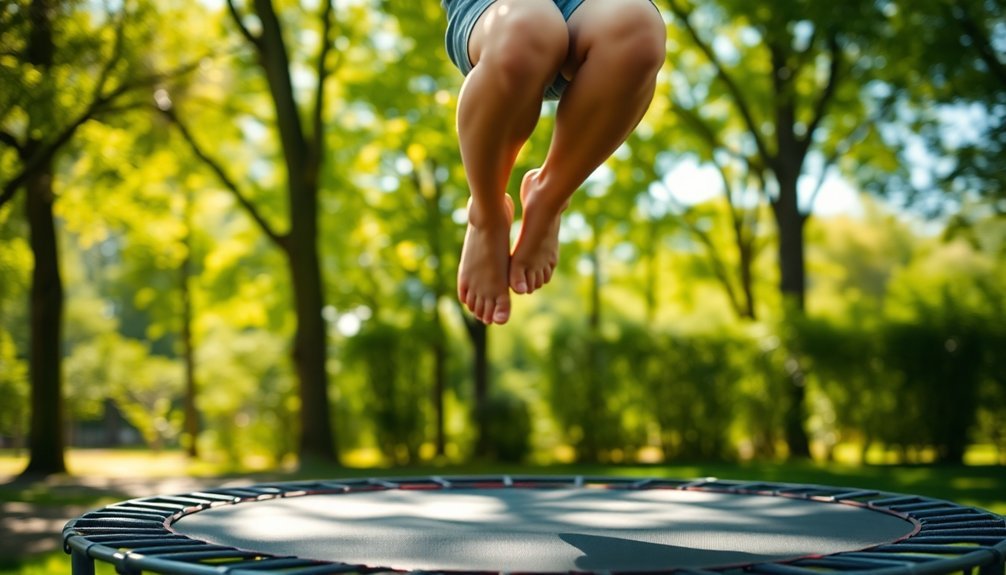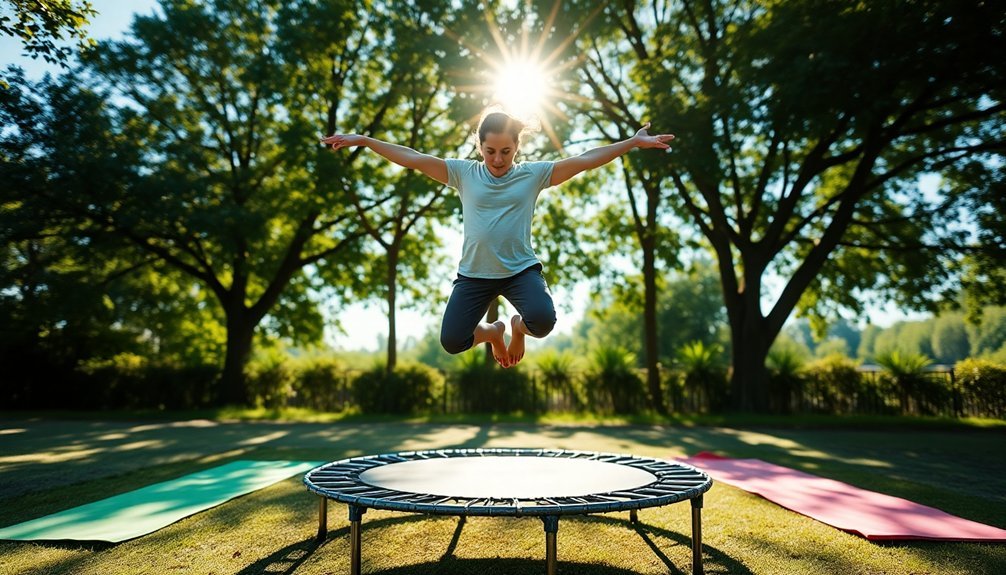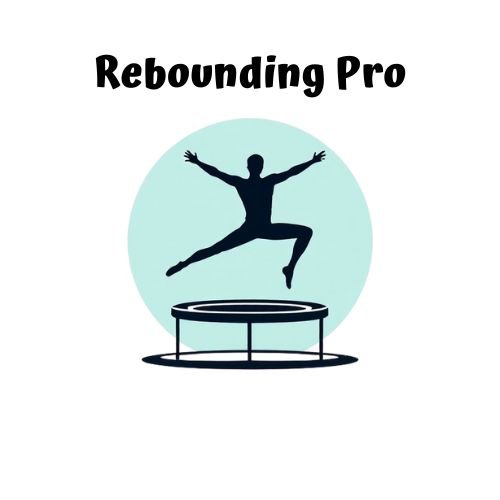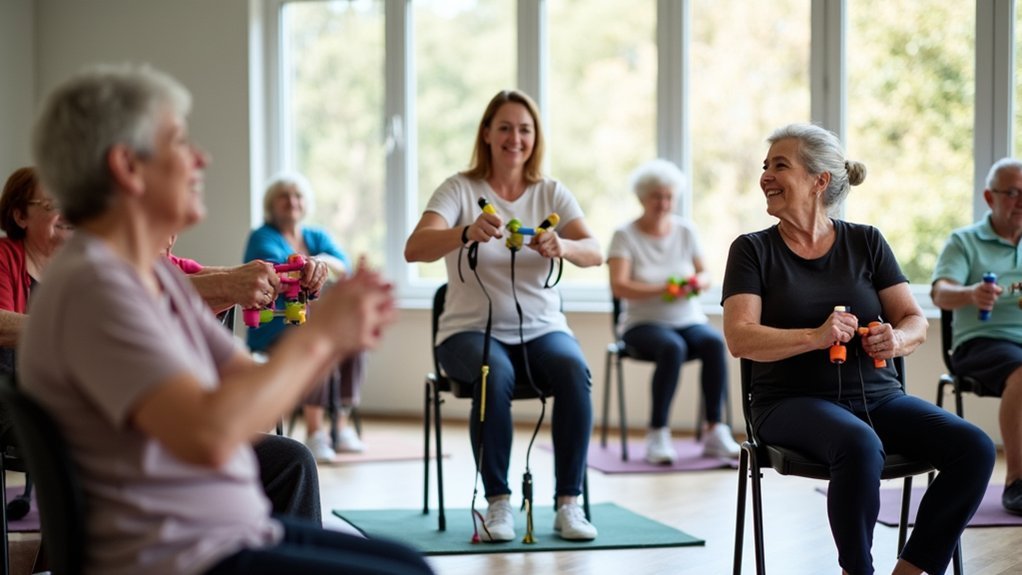Mini-trampoline rebounding naturally enhances your flexibility by creating a cycle of muscle contraction and release with each bounce. The elastic surface reduces joint compression by up to 80% compared to traditional exercises while increasing circulation and synovial fluid. You'll engage multiple muscle groups simultaneously through dynamic, multi-directional movements that improve elasticity and range of motion. Unlike static stretching, these fluid motions develop functional flexibility that serves your body better in everyday activities. Discover why fitness experts consider rebounding a superior approach to flexibility training.
How Rebounding Triggers Muscle Lengthening and Flexibility

While many fitness enthusiasts focus on the cardiovascular benefits of rebounding, its impact on flexibility is equally remarkable. Each bounce on a mini-trampoline engages multiple muscle groups simultaneously, creating a continuous cycle of contraction and release that naturally enhances muscle elasticity.
When you rebound, you're activating your legs, core, back, and abdominals through repeated movement patterns. This full-body engagement improves coordination and stimulates your postural mechanisms. Rebounding on mini-trampolines provides a safer workout option compared to larger backyard trampolines.
The G-force experienced during each bounce accelerates this muscle conditioning process while the reduced impact protects your joints.
Unlike traditional stretching, rebounding dynamically lengthens muscles through functional movement. Your body naturally responds to the gravitational changes by adjusting muscle tension, ultimately improving your range of motion and overall flexibility through these biomechanical effects.
The Unique Elastic Response That Enhances Joint Mobility
The elastic surface of a mini-trampoline creates a gentle decompression effect on your joints with each bounce, allowing them to move more freely without compression stress.
Your joints benefit from the multi-directional movements you'll naturally perform while rebounding, which challenges mobility in ways traditional exercises can't match.
This combination of assisted decompression and varied movement patterns helps increase your overall joint mobility and range of motion over time. Regular rebounding promotes limberness and flexibility while reducing the risk of injury compared to high-impact exercises on hard surfaces.
Assisted Joint Decompression
Bouncing on a mini-trampoline creates a distinctive elastic response that naturally decompresses your joints with each movement. The spring-supported surface absorbs impact while allowing your joints to move freely, distributing force evenly throughout your body.
| Joint Benefit | How It Works |
|---|---|
| Reduced Stress | Springs absorb shock that would normally impact knees and ankles |
| Enhanced Mobility | Gentle bouncing increases synovial fluid circulation |
| Improved Flexibility | Low-impact movement allows joints to extend without strain |
| Pain Reduction | Decreased compression helps alleviate inflammation |
Your joints experience gentle expansion during each bounce as gravity's effect temporarily diminishes at the top of your movement. This creates micro-moments of decompression that can improve circulation to cartilage and surrounding tissues, helping reduce inflammation while promoting better overall joint health. Smaller indoor mini-trampolines with bungee cords provide a smoother bouncing experience that further protects sensitive joints and enhances flexibility training.
Multi-Directional Movement Benefits
Multi-directional movement on mini-trampolines creates a unique elastic response that goes beyond simple joint decompression. When you bounce, you're not just moving up and down—you're engaging muscles from all angles, enhancing communication between your joints and nervous system.
This dynamic environment forces your body to constantly adjust, improving your balance reactions and coordination. As you shift directions on the unstable surface, your muscles contract in varied patterns, stimulating enhanced flexibility and proprioception. Your body learns to move more efficiently through space.
The rebounding action strengthens your postural mechanisms while training your neuromuscular system to adapt quickly. This translates to improved joint mobility and overall flexibility that benefits everyday movements.
You'll notice your body becoming more responsive and agile with regular practice.
Mini-Trampoline Warm-Up Sequences for Maximum Flexibility Gains

You'll see dramatic flexibility improvements when you start with dynamic stretching sequences on your mini-trampoline.
Begin with gentle bounces and gradually increase your range of motion as your muscles warm up.
Incorporate arm circles, hip rotations, and knee lifts to prepare your entire body for deeper stretching while taking advantage of the trampoline's elastic response. Maintain a soft knee bend throughout your movements to protect joints while maximizing the flexibility benefits of rebounding exercises.
Dynamic Stretching Sequences
When properly integrated into your mini-trampoline routine, dynamic stretching sequences create the perfect foundation for enhanced flexibility gains.
These controlled movements—including hip circles, arm swings, and leg swings—engage multiple muscle groups simultaneously while reducing stiffness.
Begin with a brief warm-up to prepare your muscles, then incorporate joint rotations that target major mobility points like shoulders and hips.
You'll experience mild discomfort (never pain) as your range of motion improves.
The trampoline's unstable surface naturally enhances your balance and coordination while you stretch.
Dynamic stretching is most effective when performed while the body is already warm and activated, which mini-trampoline bouncing naturally facilitates.
Gentle Bounce Progression
A gentle bounce progression forms the cornerstone of any effective mini-trampoline flexibility routine.
Starting with simple marches in place, you'll activate your lower body while improving circulation to your hips and legs. As you bounce, your body experiences momentary weightlessness, allowing muscles to fully relax before engaging again.
This natural rhythm enhances flexibility without strain. The trampoline's unstable surface forces your core to engage, improving balance while stimulating lymphatic circulation—crucial for removing toxins that can limit mobility. This low-impact exercise is particularly beneficial for older adults who need to maintain joint mobility while reducing injury risk.
Progress to knee lifts and arm swings to increase upper and lower body flexibility simultaneously. Side-to-side bounces improve ankle flexibility, while high knees warm the legs for deeper stretches.
Remember to use the handlebar for support if needed, especially when first developing your bounce technique.
Comparing Rebounding Flexibility Benefits to Traditional Stretching
While traditional stretching has long been considered the gold standard for improving flexibility, rebounding on mini-trampolines offers distinct advantages that may surprise fitness enthusiasts.
Unlike static stretching, rebounding engages your entire body simultaneously, improving dynamic flexibility while reducing joint stress by up to 80%.
You'll notice increased blood circulation as you bounce, delivering more oxygen to your muscles than traditional methods.
This repetitive motion of tensing and releasing muscles enhances elasticity while stimulating your lymphatic system—something static stretching simply can't match.
Rebounding also combines flexibility with cardiovascular benefits in a time-efficient workout.
The dynamic nature of bouncing improves your balance, coordination, and neuromuscular efficiency, engaging core muscles more effectively than many traditional stretching routines, all while protecting your joints.
For optimal results, start with short sessions of 15-20 minutes daily to gradually acclimate your body to the unique demands of rebounding exercise.
Optimal Bounce Techniques to Target Hard-to-Stretch Muscle Groups

Targeting those notoriously tight muscle groups requires specialized rebounding techniques that maximize the unique properties of mini-trampolines.
Unlock stubborn muscles with specialized rebounding that harnesses the transformative power of mini-trampoline mechanics.
Unlike traditional stretching, rebounding creates a dynamic environment where muscles lengthen and contract in rhythmic patterns, enhancing flexibility while protecting your joints.
To effectively target hard-to-reach muscles, incorporate these specialized techniques:
- Side-to-Side Bounces – Activate adductor muscles and improve lateral flexibility that's difficult to achieve with static stretching.
- Torso Twists – Engage core muscles while bouncing to increase spinal rotation and flexibility.
- Speed Skater Moves – Target hip flexors, glutes, and IT bands simultaneously with lateral movements.
- Single-Leg Bounces – Isolate and stretch hamstrings and calves while improving balance and stability.
The trampoline's shock-absorbing surface makes these exercises particularly beneficial for those with joint concerns, as it provides low-impact aerobic benefits while still effectively engaging muscles throughout the body.
Incorporating Balance Elements for Advanced Flexibility Training
Balance mastery transforms your mini-trampoline flexibility routine from basic to extraordinary.
By adding balance challenges to your rebounding workouts, you'll simultaneously enhance proprioception and core strength—two key components of advanced flexibility.
Try incorporating single-leg stances between jumps or performing lateral movements that force your body to adjust and stabilize. For an added challenge, close your eyes during gentle bounces to heighten your vestibular system's response.
These balance elements create dynamic conditions that stretch muscles from multiple angles while improving spatial awareness. Activities like mini-trampoline training can help counteract declining balance skills that naturally occur with age.
Unlike traditional static stretching, mini-trampoline balance work engages your muscles through fluid, adaptable movements that promote functional flexibility.
Your body learns to maintain proper alignment even on unstable surfaces, which translates to improved range of motion and more effective flexibility gains in your regular training routine.
Frequently Asked Questions
Can Mini-Trampolines Help With Existing Mobility Limitations?
Yes, mini-trampolines can help with your existing mobility limitations by providing low-impact exercise that improves balance, strengthens muscles, and enhances flexibility while reducing joint stress—making movement easier for conditions like neurological disorders or aging.
How Often Should Beginners Use Mini-Trampolines for Flexibility Improvements?
Start with 5-10 minute sessions, 2-3 times weekly to build your flexibility safely. You'll want to gradually increase duration as your body adapts, always including warm-up stretches before you bounce.
Are Mini-Trampolines Safe for Pregnant Women Seeking Flexibility Benefits?
Mini-trampolines can be safe during pregnancy if you've consulted your doctor first. You'll need to use safety nets, avoid flips, modify exercises with softer bounces, and stop immediately if you experience discomfort.
Can Seniors Safely Use Mini-Trampolines for Flexibility Training?
Yes, you can safely use mini-trampolines for flexibility training as a senior. They're low-impact, improve joint function, and enhance mobility. Always use safety bars, consult your doctor first, and start with gentle bounces.
Do Mini-Trampolines Increase Flexibility in Those With Chronic Conditions?
Yes, you'll find mini-trampolines can improve flexibility if you have chronic conditions. They offer low-impact movement that enhances joint mobility, strengthens supporting muscles, and improves proprioception without aggravating your condition.
In Summary
You've discovered a whole new approach to flexibility with your mini-trampoline. By incorporating regular rebounding sessions, you're not just having fun—you're triggering deeper muscle elasticity than traditional stretching alone. Don't forget to mix balance challenges with gentle bounces for ideal results. Start with the warm-up sequences we've outlined, and you'll soon notice improved joint mobility and enhanced flexibility throughout your body.





Leave a Reply